Overview
Battery lifecycle analysis (LCA) plays a pivotal role in comprehending the environmental impacts of batteries throughout their entire lifespan, from raw material extraction to disposal. This understanding is particularly critical given the surging demand for electric vehicles and renewable energy storage. LCA methodologies, adherence to regulations, cutting-edge recycling technologies, and advancements in battery design are not just beneficial; they are essential for mitigating ecological damage and fostering sustainability in energy storage systems. \n\nAs the demand for sustainable energy solutions escalates, the complexities surrounding battery production and disposal become more pronounced. The integration of innovative recycling technologies and compliance with evolving regulations can significantly reduce the ecological footprint of batteries. This proactive approach not only addresses environmental concerns but also aligns with the growing global emphasis on sustainability. \n\nThe benefits of implementing robust LCA practices are manifold. They not only enhance the understanding of a battery's environmental impact but also pave the way for more sustainable practices in the industry. In light of these challenges and opportunities, it is imperative for stakeholders in the energy sector to prioritize LCA as a fundamental component of their operational strategies. \n\nIn conclusion, embracing LCA methodologies and innovative technologies is not merely a regulatory requirement; it is a strategic imperative for promoting sustainability in energy storage systems. The time to act is now, as the future of our environment depends on the choices we make today.
Introduction
As the world increasingly shifts towards renewable energy and electric vehicles, the significance of comprehending the entire lifecycle of batteries cannot be overstated.
Battery lifecycle analysis (LCA) emerges as an essential tool for evaluating the environmental impacts associated with each stage of a battery's existence, from raw material extraction to disposal.
The surging demand for sustainable energy solutions necessitates a thorough examination of resource consumption and emissions, underscoring the need for innovative recycling methods and enhanced safety measures.
With insights drawn from recent studies and case analyses, this article explores the critical aspects of battery lifecycle management, providing a comprehensive overview of current practices, challenges, and future trends that are shaping a more sustainable battery industry.
Introduction to Battery Lifecycle Analysis: Significance and Overview
Battery lifecycle analysis (LCA) serves as a critical framework for assessing environmental impacts throughout the entire lifespan of a battery, encompassing raw material extraction, manufacturing, usage, and final disposal. As the demand for power sources in electric vehicles and renewable energy storage systems grows, the necessity of battery lifecycle analysis intensifies for identifying and mitigating environmental consequences. This systematic approach equips stakeholders with valuable insights into resource consumption and emissions, pinpointing potential areas for improvement in both production and usage.
Francesco Tola's systematic review of energy storage life cycle management underscores that robust analysis is essential for achieving compliance with European regulations. Furthermore, proposed enhancements for energy storage safety, including advancements in thermal stability and the integration of protective features in designs, are vital for ensuring safe usage. Innovative recycling technologies, as highlighted in the case study 'Innovative Recycling Technologies for Lithium-Ion Batteries,' illustrate emerging techniques such as direct recovery processes and waterjet-based recycling, which significantly reduce harm and greenhouse gas emissions compared to traditional methods.
Recent data indicates that converting mixed-stream lithium-ion cells into high-quality materials can diminish ecological effects by at least 58%, underscoring the urgent need for sustainable practices within the industry. Additionally, ongoing research is focused on enhancing energy storage safety through design optimization, material selection, and monitoring methods for mechanical abuse, providing a timely perspective on current advancements. Through effective battery lifecycle analysis, manufacturers and policymakers can make informed decisions that not only align with sustainability goals but also contribute to a cleaner, more sustainable future.
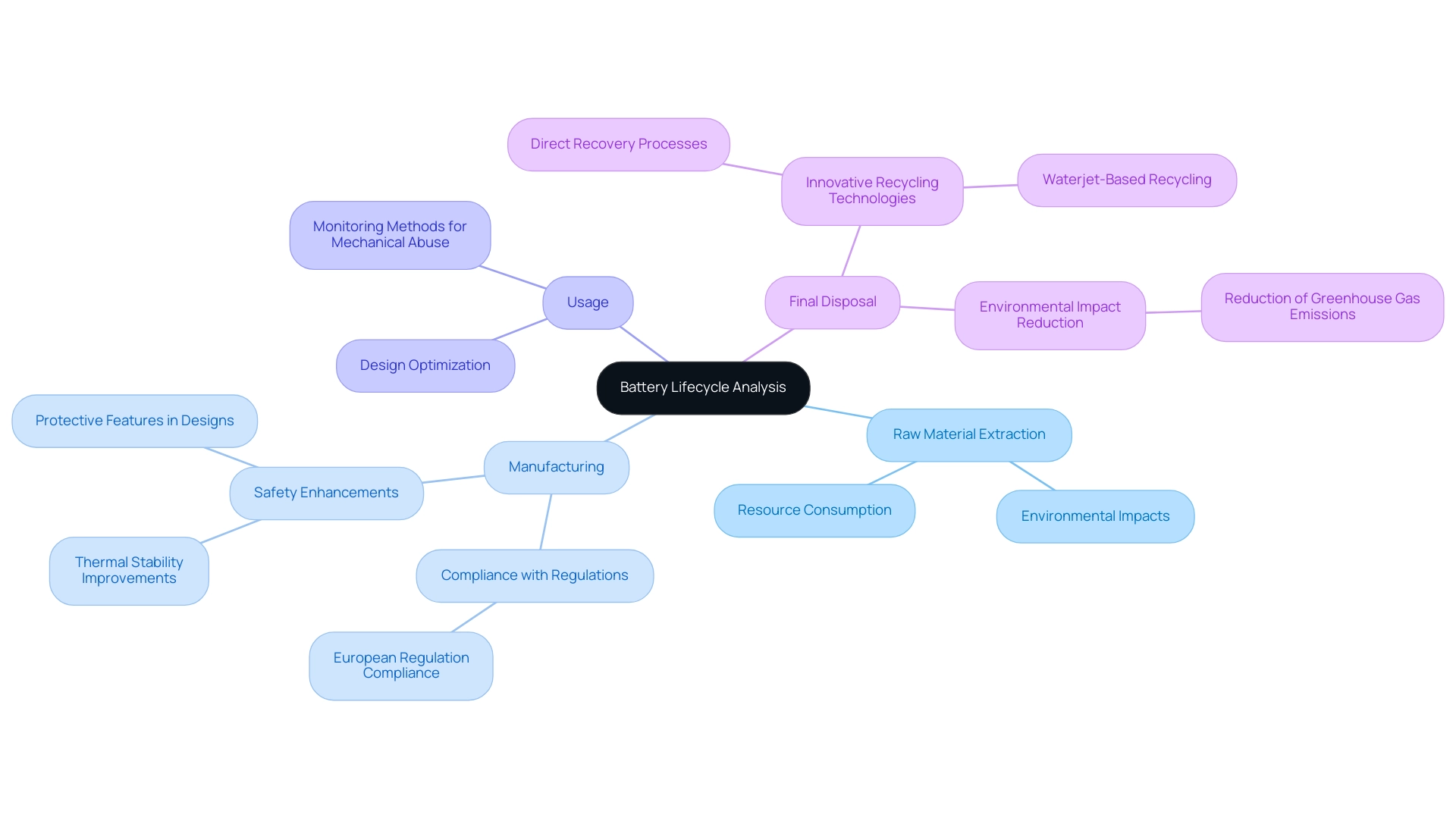
Stages of the Battery Lifecycle: From Raw Materials to Disposal
The lifecycle of an energy storage unit encompasses several critical stages that significantly influence environmental sustainability.
-
Raw Material Extraction marks the initial phase, where essential materials such as lithium, cobalt, and nickel are sourced. This process often leads to considerable environmental degradation. Notably, recent studies indicate that countries like China contribute to 45% of total greenhouse gas emissions from lithium-ion cell manufacturing, underscoring the urgent need for enhanced supply chains to mitigate global emissions. Furthermore, projections show that China's GHG emissions from electricity generation are expected to decline from 0.842 kg CO2 eq/kWh in 2020 to 0.078 kg CO2 eq/kWh by 2050, highlighting the potential for decarbonization within energy storage.
-
Manufacturing follows, encompassing material processing, electrode fabrication, and cell assembly. Each of these steps contributes to the overall environmental footprint of energy storage device production. Recent reports emphasize the substantial energy consumption associated with these processes, necessitating a shift towards integrating renewable energy sources to lower emissions. The anticipated decarbonization of the European electricity grid is projected to significantly reduce GHG emissions in energy storage production by 2050.
-
Usage of batteries spans various applications, including electric vehicles and stationary storage systems, both of which are pivotal in the transition to sustainable energy. Yang Shao-Horn, JR East Professor of Engineering at MIT, asserts,
If we have more energy storage, we would be able to increase load level and then use [renewable energy] when we have more demand.
-
Finally, the End-of-Life stage addresses the critical importance of proper disposal or recycling of energy cells to minimize environmental impacts.
Moreover, the case study titled 'Geographical Distribution of Accumulator Emissions' reveals that China alone accounts for a significant portion of total accumulator emissions, emphasizing the necessity for optimized supply chains. Understanding these stages is essential for developing comprehensive strategies that incorporate battery lifecycle analysis, focusing on enhancing sustainability throughout the lifecycle and reducing greenhouse gas emissions associated with electric vehicles.
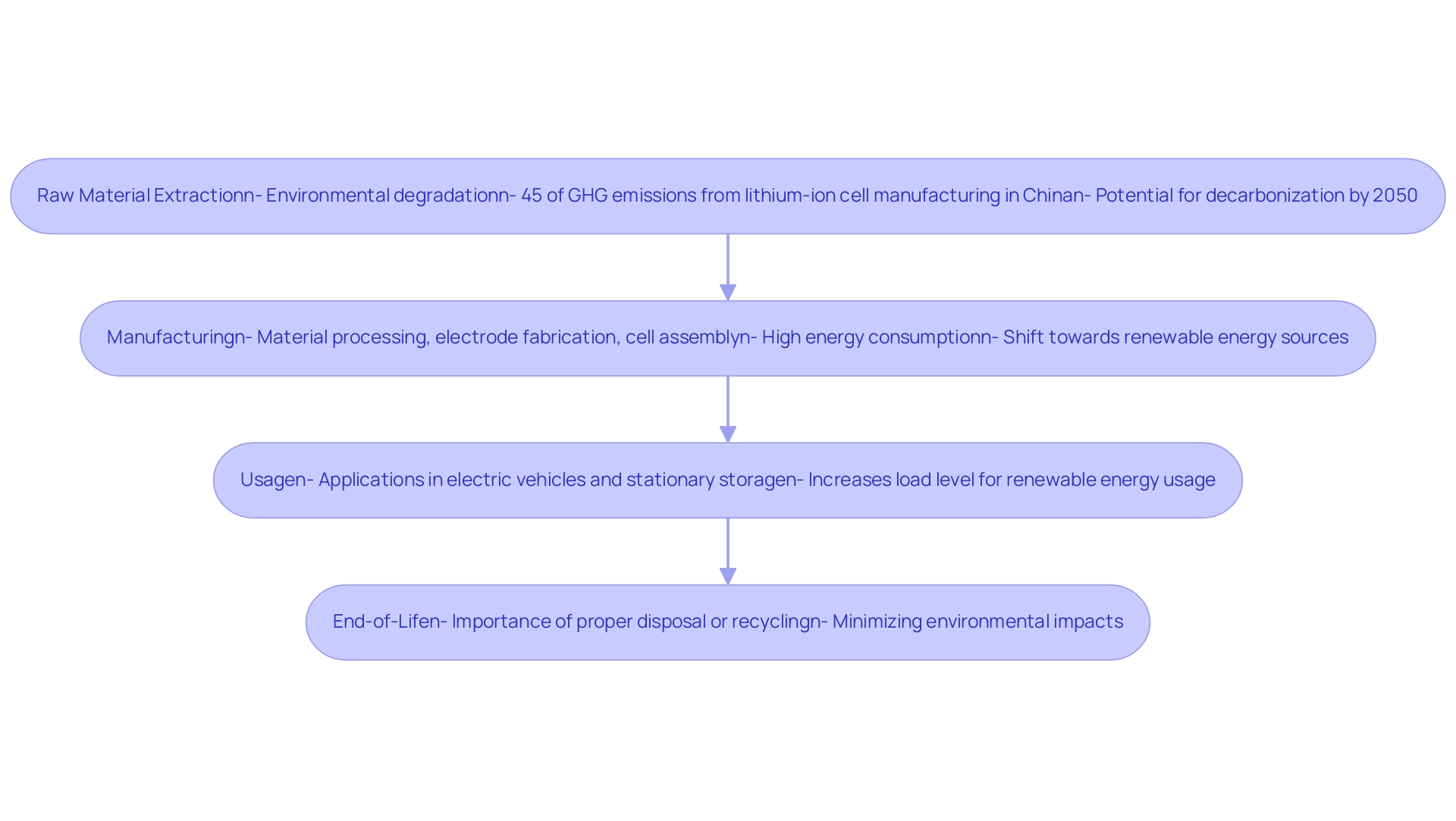
Environmental Impacts of Battery Production and Usage
The ecological effects of producing and using rechargeable cells are both significant and intricate. The extraction of raw materials, particularly nickel and cobalt, leads to substantial habitat destruction, soil erosion, and water pollution. Mining activities account for approximately 10-20% of deforestation in major mining regions, highlighting the urgent need for sustainable sourcing practices and stricter environmental regulations to safeguard water supplies.
As ADEME indicated, these figures differ from those reported by ADEME in 2013, which stated that electric vehicles produce 9 tons of CO2, while internal combustion vehicles generate 22 tons, factoring in the battery lifecycle analysis of accumulators. The manufacturing phase is equally concerning, as it produces considerable greenhouse gas emissions. While energy storage devices facilitate the transition to cleaner energy options, their manufacturing processes still significantly contribute to overall carbon footprints.
Moreover, improper disposal practices pose severe risks, with hazardous waste potentially leaching into the environment, resulting in soil and water contamination. To mitigate these effects, a coordinated strategy is essential, emphasizing advancements in recycling technologies, ensuring safe disposal of cells, and enhancing the renewable energy mix used in cell manufacturing. Understanding these complex effects is critical for identifying opportunities for innovation and improvement in practices related to battery lifecycle analysis and energy storage technologies.
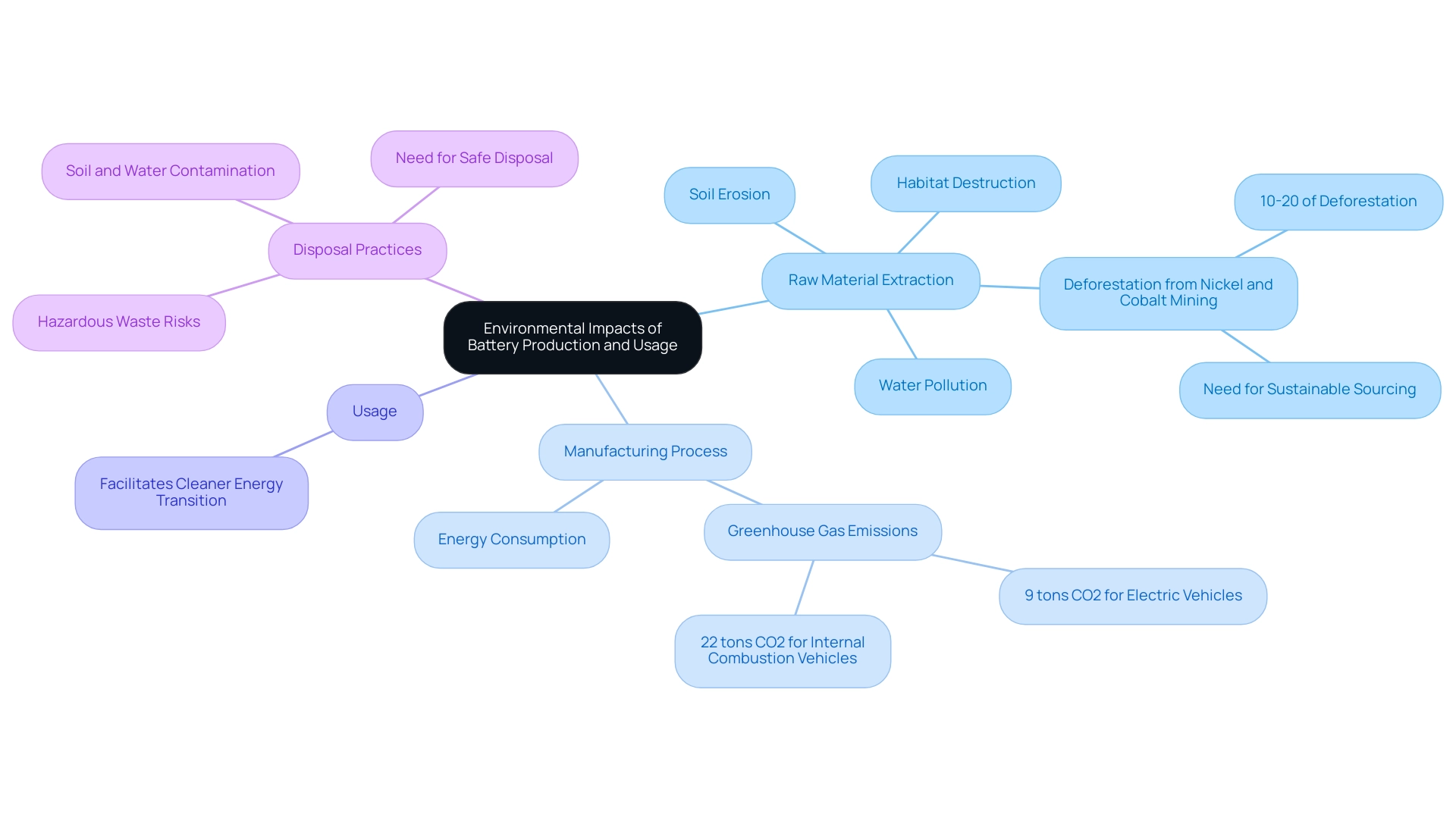
Methodologies for Conducting Battery Lifecycle Assessments
Carrying out a battery lifecycle analysis is essential for understanding the impacts associated with cell manufacturing and usage. The ISO 14040 and 14044 standards provide foundational guidelines for these assessments, ensuring a systematic approach to evaluating sustainability. The process typically begins with a clear definition of the goal and scope, followed by inventory analysis, which quantifies all relevant inputs and outputs.
Next, the assessment evaluates ecological impacts, while the interpretation of results informs effective decision-making. Key metrics such as carbon footprint, energy consumption, and resource depletion are vital in measuring sustainability. Notably, the plug-in bus equipped with a 400 kWh lithium iron phosphate (LFP) power source demonstrates the most significant influence across all ecological categories, underscoring the emission intensity of power source production.
Moreover, integrating renewable energy systems for electric vehicle (EV) charging stations can lead to a substantial reduction in carbon footprint, potentially by as much as 89.8%, as highlighted by Faisal et al. By implementing these strategies, organizations can identify critical areas for improvement and develop comprehensive plans to mitigate ecological impacts through battery lifecycle analysis throughout the product's entire lifecycle. Furthermore, adherence to ISO standards enhances the credibility of these assessments.
The case study titled 'A Path Toward Systemic Equity in Life Cycle Assessment and Decision-Making' exemplifies this principle, presenting a framework that underscores the necessity for thorough data collection and equitable decision-making in energy and environmental research. This framework aligns with the methodologies discussed, reinforcing the importance of integrating social equity into lifecycle assessments. Additionally, the ISO standards for greenhouse gas emissions reporting, including ISO 14064 and ISO 14067, offer further guidelines that are crucial for sustainability practices in lifecycle assessments.
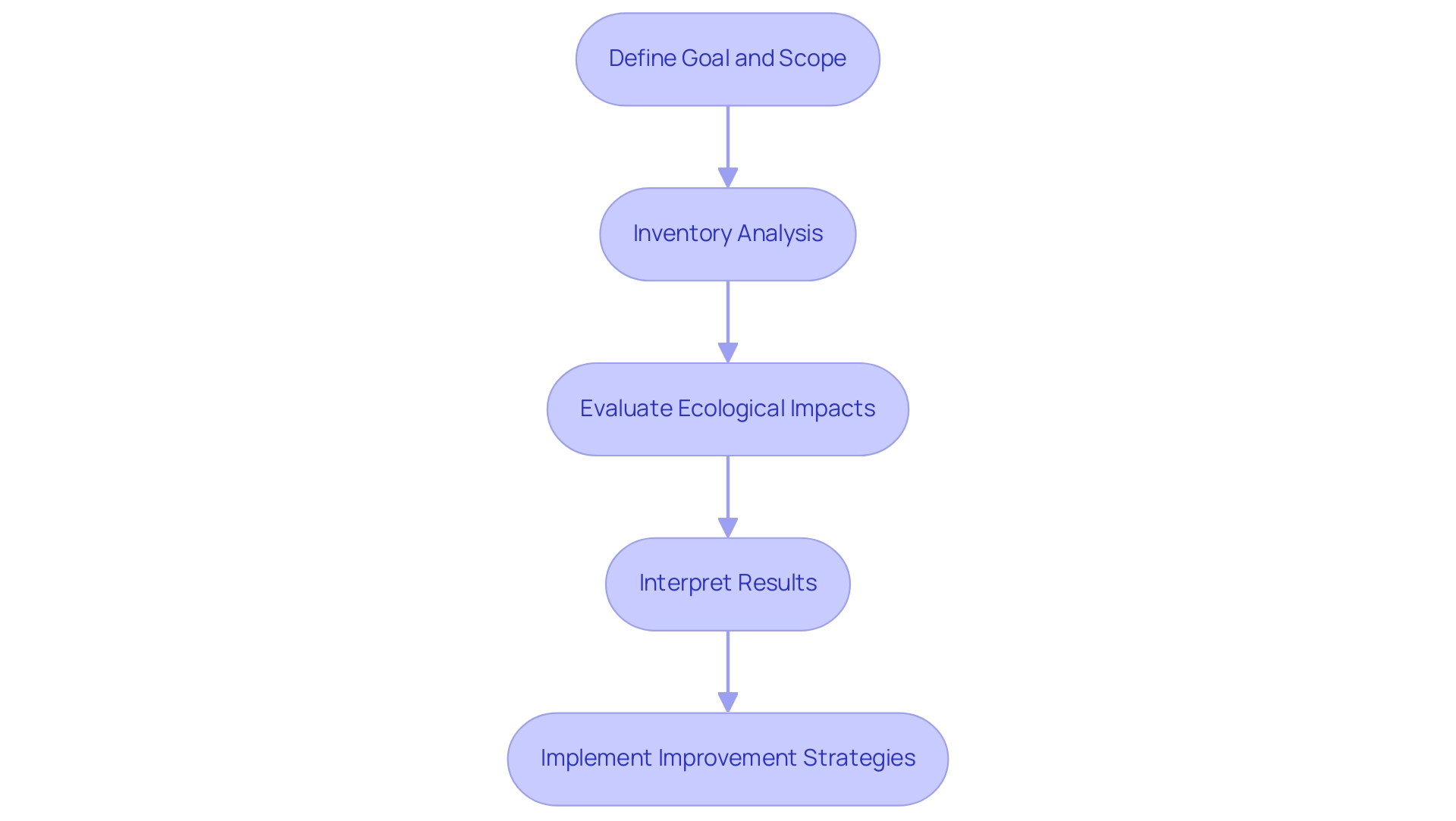
The Role of Recycling in Battery Lifecycle Management
Recycling is vital in battery lifecycle analysis, playing a key role in recovering valuable materials and minimizing reliance on new raw material extraction. Currently, fewer than 5% of end-of-life lithium-ion cells are collected and recycled, highlighting a significant opportunity for improvement that must not be overlooked. As Bruna Alves, a research lead in environment and sustainability, emphasizes, "The significance of recycling cannot be overstated; it is essential for a sustainable energy ecosystem."
Efficient recycling methods are crucial for battery lifecycle analysis, as they mitigate the environmental impacts of disposal, including reducing hazardous waste and emissions. Techniques such as hydrometallurgical and pyrometallurgical methods are employed to extract critical metals like lithium, cobalt, and nickel from used power sources. This is particularly relevant as new recycling plants are being established globally, with notable projects underway in regions such as North America and Europe, spurred by record-high electric vehicle sales that underscore the importance of battery lifecycle analysis.
Notably, Ganfeng Lithium has reported a recycling capacity of 200,000 metric tons, reflecting the industry's commitment to enhancing resource efficiency and sustainability. Furthermore, a case study titled 'Distribution Of EV Recycling By Source' reveals that in 2020, 52% of EV units were sourced from end-of-life sources, a figure expected to rise to 94% by 2040. By promoting recycling and investing in advanced recovery technologies, the industry can significantly reduce costs while contributing to a more sustainable future.
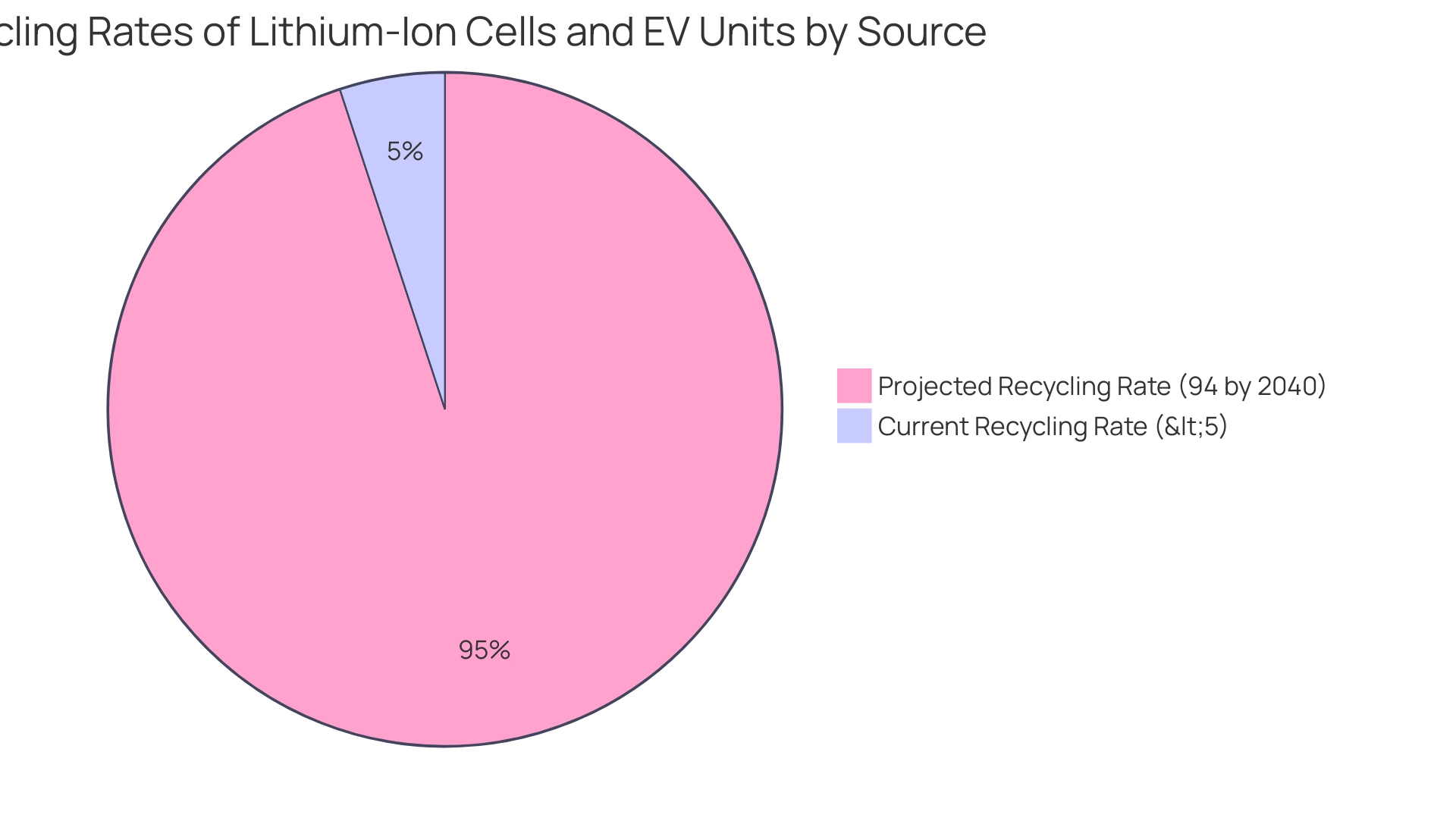
Future Trends in Battery Technology and Lifecycle Analysis
The future of energy storage technology and battery lifecycle analysis is poised to bring about significant advancements in sustainability. Solid-state power sources, noted for their ability to provide higher energy densities and enhanced safety, are increasingly at the forefront of industry discussions. Importantly, approximately 65% of energy cells and nearly 80% of cathodes are produced in China, highlighting the necessity of comprehending market dynamics within this sector.
Moreover, innovative recycling technologies, particularly direct recycling methods, are being developed to improve material recovery rates while reducing environmental impacts. This is a vital step, as the recycling segment for energy storage materials is expected to grow more than three-fold in the next decade. The integration of artificial intelligence and machine learning into battery lifecycle analysis is anticipated to enhance data accuracy and improve decision-making processes, thereby facilitating better resource management and sustainability outcomes. Given the tightening regulatory frameworks surrounding energy storage production and disposal, it is crucial for companies to adopt these innovations to remain competitive and comply with evolving sustainability standards.
As Guy Éthier, former Chairman of the Board of Directors for the Global Battery Alliance, remarked, 'Three years ago, McKinsey supported GBA and demonstrated the significance of a pre-competitive transparent energy value chain to drive the energy transformation; today’s updated report magnifies not only the significance but also the scale and urgency.' Additionally, fluctuations in prices and availability of critical minerals have impacted the shift in chemistry, leading to a transition towards lower-cobalt ratios in NMC technologies due to rising cobalt prices and public concerns. This shift has resulted in an increased utilization of LFP batteries, which are less dependent on costly materials, although their prices have also escalated due to the rising cost of lithium.
Thus, the convergence of these trends is not merely advantageous but essential for the future of energy storage.
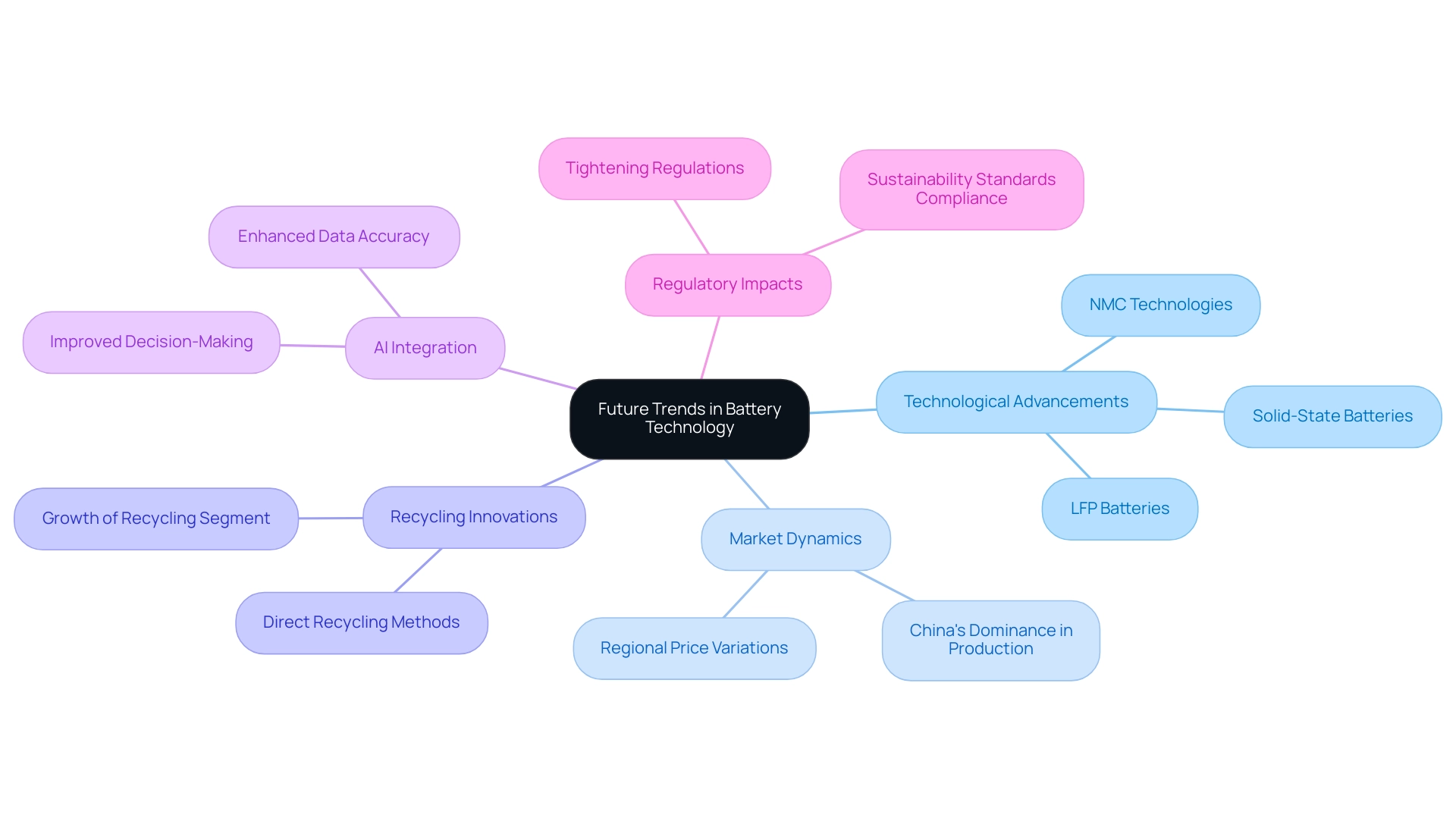
Conclusion
The exploration of battery lifecycle analysis underscores its vital role in cultivating a sustainable battery industry. By comprehensively understanding each stage of a battery's lifecycle—from raw material extraction and manufacturing to usage and end-of-life management—stakeholders can pinpoint significant environmental challenges and opportunities for enhancement. The focus on innovative recycling methods and improved safety measures is crucial, as these practices not only diminish greenhouse gas emissions but also conserve valuable resources essential for future battery production.
Furthermore, the urgent necessity for sustainable practices is highlighted by alarming statistics regarding current recycling rates and the environmental repercussions of battery production. With less than 5% of lithium-ion batteries being recycled, there exists a substantial opportunity for growth in recycling initiatives, which can markedly reduce the ecological footprint of batteries. As advancements in technology and methodologies progress, the integration of artificial intelligence and machine learning into lifecycle assessments is set to enhance data accuracy and decision-making, ultimately fostering better resource management.
Looking ahead, the shift toward solid-state batteries and the expansion of recycling technologies herald a promising future for the battery industry. Embracing these innovations and adhering to stricter regulatory frameworks will be essential for companies striving to remain competitive while contributing to a cleaner, more sustainable energy landscape. The collective commitment to enhancing battery lifecycle management is not merely an environmental imperative; it is a crucial step toward realizing a sustainable energy future for generations to come.
Frequently Asked Questions
What is battery lifecycle analysis (LCA)?
Battery lifecycle analysis (LCA) is a framework used to assess the environmental impacts of a battery throughout its entire lifespan, including raw material extraction, manufacturing, usage, and final disposal.
Why is battery lifecycle analysis becoming more important?
As the demand for electric vehicles and renewable energy storage systems increases, the need for battery lifecycle analysis grows to identify and mitigate environmental consequences associated with these technologies.
What insights does battery lifecycle analysis provide?
It offers valuable insights into resource consumption and emissions, helping stakeholders identify areas for improvement in both battery production and usage.
What role does battery lifecycle analysis play in compliance with regulations?
Robust lifecycle analysis is essential for achieving compliance with European regulations regarding energy storage and environmental sustainability.
What advancements are necessary for energy storage safety?
Enhancements such as improved thermal stability and the integration of protective features in battery designs are vital for ensuring safe usage.
What innovative recycling technologies are being developed for lithium-ion batteries?
Emerging recycling techniques, such as direct recovery processes and waterjet-based recycling, aim to significantly reduce harm and greenhouse gas emissions compared to traditional methods.
How can converting mixed-stream lithium-ion cells impact the environment?
Converting these cells into high-quality materials can diminish ecological effects by at least 58%, highlighting the need for sustainable practices in the industry.
What stages are involved in the lifecycle of an energy storage unit?
The lifecycle includes four critical stages: raw material extraction, manufacturing, usage, and end-of-life disposal or recycling.
What are the environmental concerns associated with raw material extraction?
The extraction of materials like lithium, cobalt, and nickel can lead to significant environmental degradation, with countries like China contributing notably to greenhouse gas emissions from lithium-ion cell manufacturing.
How does manufacturing affect the environmental footprint of energy storage devices?
The manufacturing process, which includes material processing, electrode fabrication, and cell assembly, is energy-intensive and contributes to the overall environmental footprint, necessitating a shift towards renewable energy sources.
What is the significance of the usage stage in battery lifecycle?
The usage of batteries in electric vehicles and stationary storage systems is crucial for transitioning to sustainable energy and maximizing the use of renewable energy.
Why is the end-of-life stage important in battery lifecycle analysis?
Proper disposal or recycling of energy cells is essential to minimize environmental impacts and ensure sustainability throughout the battery's lifecycle.

